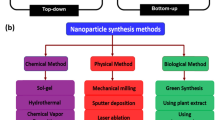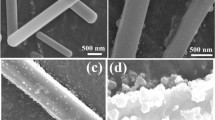Abstract
In this study, WO3 nanoparticles with hierarchical structures are prepared by a simple hydrothermal method using diammonium hydrogen citrate (C6H14N2O7) as an additive, and the effects of reaction temperature and addition of C6H14N2O7 on their morphology are investigated in detail. The physical properties and morphology of the prepared WO3 materials are analyzed by scanning electron microscopy, X-ray diffraction , transmission electron microscopy, and Brunauer–Emmett–Teller method, and a possible growth mechanism is proposed. The results show that C6H14N2O7 is adsorbed on the edges of the nanosheets and inhibits their anisotropic growth. In addition, based on this material, sensors are self-assembled for detecting the decomposition products of SF6, and the gas-sensitive properties of the material are investigated. The experimental results show that the sensors based on WO3 with hierarchical structures are highly sensitive to H2S and exhibit a low operating temperature. This indicates that such sensors can be effectively used to detect the main decomposition products of SF6.



















Similar content being viewed by others
References
Christophorou LG, Olthoff JK, Brunt RJV (1997) Sulfur hexafluoride and the electric power industry. IEEE Electr Insul Mag 13:20–24. https://doi.org/10.1109/57.620514
Schumb W (1947) Preparation and properties of sulfur hexafluoride. Ind Eng Chem 39:421–423. https://doi.org/10.1021/ie50447a642
Gui X, Zhou Q, Peng S, Xu L, Zeng W (2020) Adsorption behavior of Rh -doped MoS2 monolayer towards SO2, SOF2, SO2F2 based on DFT study. Physica E-Low-Dimens Syst Nanostruct. https://doi.org/10.1016/j.physe.2020.114224
Hirooka K, Kuwahara H, Noshiro M, Jitsugiri Y (1975) Decomposition products of SF6 gas by high-current arc and their reaction mechanism. Electrical Eng Japan 95:14–19. https://doi.org/10.1002/eej.4390950603
Gao Q, Wang X, Yang A et al (2019) Influence of H2O and O2 on the main discharge mechanism in 50 Hz ac point-plane corona discharge. Phys Plasmas 26:033508. https://doi.org/10.1063/1.5072777
Zhang X, Cui Z, Li Y, Xiao H, Li Y, Tang J (2018) Study on degradation of SF6 in the presence of H2O and O2 using dielectric barrier discharge. IEEE Access 6:72748–72756. https://doi.org/10.1109/ACCESS.2018.2879157
Liu H, Zhou Q, Zhang Q et al (2017) Synthesis, characterization and enhanced sensing properties of a NiO/ZnO p-n junctions sensor for the SF6 decomposition byproducts SO2, SO2F2, and SOF2. Sensors. https://doi.org/10.3390/s17040913
Brunt RJv, Herron JT (1994) Plasma chemical model for decomposition of SF6 in a negative glow corona discharge. Phys Scr T53(9):29. https://doi.org/10.1088/0031-8949/1994/t53/002
Tang J, Zeng F, Zhang X et al (2014) Influence regularity of trace O2 on SF6 decomposition characteristics and its mathematical amendment under partial discharge. IEEE Trans Dielectr Electr Insul 21:105–115. https://doi.org/10.1109/TDEI.2013.003795
Baek K-H, Yoon Y-S, Park J-M, Kwon K-H, Chang-Il K, Nam K-S (1998) A fluorine-related passivation layer on etched Al-Cu (1%) alloy surfaces on silicon after SF6 plasma treatments. Mater Lett 35:183–187. https://doi.org/10.1016/S0167-577X(97)00243-7
Tang J, Rao X, Tang B et al (2017) Investigation on SF6 spark decomposition characteristics under different pressures. IEEE Trans Dielectr Electr Insul 24:2066–2075. https://doi.org/10.1109/TDEI.2017.006326
Yang D, Zeng F, Yang X et al (2018) Comparison of SF6 decomposition characteristics under negative DC partial discharge initiated by two kinds of insulation defects. IEEE Trans Dielectr Electr Insul 25:863–872. https://doi.org/10.1109/TDEI.2018.006701
Chu FY (1986) SF6 Decomposition in gas-insulated equipment. IEEE Trans Electr Insul 21:693–725. https://doi.org/10.1109/TEI.1986.348921
Braun JM, Chu FY (1986) Novel low-cost SF6 arcing byproduct detectors for field use in gas-insulated switchgear. IEEE Trans Power Delivery 1:81–86. https://doi.org/10.1109/TPWRD.1986.4307937
Kim H-J, Lee J-H (2014) Highly sensitive and selective gas sensors using p-type oxide semiconductors: overview. Sens Actuators B Chem 192:607–627. https://doi.org/10.1016/j.snb.2013.11.005
Leidinger M (2018) Methods for increasing the sensing performance of metal oxide semiconductor gas sensors at ppb concentration levels. Ph.D Dissertation, University of Saarland
Ansari SG, Boroojerdian P, Sainkar SR, Karekar RN, Aiyer RC, Kulkarni SK (1997) Grain size effects on H2 gas sensitivity of thick film resistor using SnO2 nanoparticles. Thin Solid Films 295:271–276. https://doi.org/10.1016/S0040-6090(96)09152-3
Xu L, Zeng W, Li Y (2018) Synthesis of morphology and size-controllable SnO2 hierarchical structures and their gas-sensing performance. Appl Surf Sci 457:1064–1071. https://doi.org/10.1016/j.apsusc.2018.07.018
Kim M-H, Jang J-S, Koo W-T et al (2018) Bimodally porous WO3 microbelts functionalized with Pt catalysts for selective H2S sensors. ACS Appl Mater Interfaces 10:20643–20651. https://doi.org/10.1021/acsami.8b00588
Wei Z, Zhou Q, Zeng W (2020) Hierarchical WO3-NiO microflower for high sensitivity detection of SF6 decomposition byproduct H2S. Nanotechnology 31:215701. https://doi.org/10.1088/1361-6528/ab73bd
Bhati VS, Hojamberdiev M, Kumar M (2020) Enhanced sensing performance of ZnO nanostructures-based gas sensors: a review. Energy Rep 6:46–62. https://doi.org/10.1016/j.egyr.2019.08.070
Kida T, Nishiyama A, Hua Z, Suematsu K, Yuasa M, Shimanoe K (2014) WO3 nanolamella gas sensor: porosity control using SnO2 nanoparticles for enhanced NO2 sensing. Langmuir 30:2571–2579. https://doi.org/10.1021/la4049105
Ghosh S, Adak D, Bhattacharyya R, Mukherjee N (2017) ZnO/γ-Fe2O3 charge transfer interface toward highly selective H2S sensing at a low operating temperature of 30 °C. ACS Sens 2:1831–1838. https://doi.org/10.1021/acssensors.7b00636
Xu Z, Luo Y, Duan G (2019) Self-assembly of Cu2O monolayer colloidal particle film allows the fabrication of CuO sensor with superselectivity for hydrogen sulfide. ACS Appl Mater Interfaces 11:8164–8174. https://doi.org/10.1021/acsami.8b17251
Supothina S, Suwan M, Wisitsoraat A (2014) Hydrothermal synthesis of K2W4O13 nanowire with high H2S gas sensitivity. Microelectron Eng 126:88–92. https://doi.org/10.1016/j.mee.2014.06.015
Wang Y, Liu B, Xiao S et al (2016) Low-temperature H2S detection with hierarchical Cr-doped WO3 microspheres. ACS Appl Mater Interfaces 8:9674–9683. https://doi.org/10.1021/acsami.5b12857
Singh S, Dogra N, Sharma S (2020) A sensitive H2S sensor using MoS2/WO3 composite. Mater Today Proc 28:8–10. https://doi.org/10.1016/j.matpr.2019.12.104
Minh Vuong N, Kim D, Kim H (2015) Porous Au-embedded WO3 nanowire structure for efficient detection of CH4 and H2S. Sci Rep 5:11040. https://doi.org/10.1038/srep11040
Zhou Q, Xu L, Umar A, Chen W, Kumar R (2018) Pt nanoparticles decorated SnO2 nanoneedles for efficient CO gas sensing applications. Sens Actuators B Chem 256:656–664. https://doi.org/10.1016/j.snb.2017.09.206
Xiao B, Zhao Q, Xiao C et al (2015) Low-temperature solvothermal synthesis of hierarchical flower-like WO3 nanostructures and their sensing properties for H2S. Cryst Eng Comm 17:5710–5716. https://doi.org/10.1039/C5CE00870K
Pawar RC, Shaikh JS, Suryavanshi SS, Patil PS (2012) Growth of ZnO nanodisk, nanospindles and nanoflowers for gas sensor: pH dependency. Curr Appl Phys 12:778–783. https://doi.org/10.1016/j.cap.2011.11.005
Wang B, Ma S, Pei S et al (2020) High specific surface area SnO2 prepared by calcining Sn-MOFs and their formaldehyde-sensing characteristics. Sens Actuators B Chem 321:128560. https://doi.org/10.1016/j.snb.2020.128560
Liu W, Qu Y, Li H et al (2019) Nanostructure Bi2WO6: Surfactant-assisted hydrothermal synthesis for high sensitive and selective sensing of H2S. Sens Actuators B Chem 294:224–230. https://doi.org/10.1016/j.snb.2019.05.042
Zhao Z-G, Miyauchi M (2009) Shape modulation of tungstic acid and tungsten oxide hollow structures. J Phys Chem C 113:6539–6546. https://doi.org/10.1021/jp900160u
Xu W, Qiu C, Zhou J, Chen Y (2020) Regulation of specific surface area of 3D flower-like WO3 hierarchical structures for gas sensing application. Ceram Int 46:11372–11378. https://doi.org/10.1016/j.ceramint.2020.01.167
Zhang F, Xu Y, Zhang X et al (2018) Highly selective ppb-level H2S sensor based on the walnut-like Bi2MoO6 at low temperature. Sens Actuators B Chem 277:312–319. https://doi.org/10.1016/j.snb.2018.08.151
Dun M, Tan J, Tan W, Tang M, Huang X (2019) CdS quantum dots supported by ultrathin porous nanosheets assembled into hollowed-out Co3O4 microspheres: A room-temperature H2S gas sensor with ultra-fast response and recovery. Sens Actuators B Chem 298:126839. https://doi.org/10.1016/j.snb.2019.126839
Yu H, Song Z, Liu Q et al (2017) Colloidal synthesis of tungsten oxide quantum dots for sensitive and selective H2S gas detection. Sens Actuators B Chem 248:1029–1036. https://doi.org/10.1016/j.snb.2017.03.044
Yin L, Chen D, Hu M et al (2014) Microwave-assisted growth of In2O3 nanoparticles on WO3 nanoplates to improve H2S-sensing performance. J Mater Chem A 2:18867–18874. https://doi.org/10.1039/C4TA03426K
Wu Z, Li Z, Li H et al (2019) Ultrafast response/recovery and high selectivity of the H2S gas sensor based on α-Fe2O3 nano-ellipsoids from one-step hydrothermal synthesis. ACS Appl Mater Interfaces 11:12761–12769. https://doi.org/10.1021/acsami.8b22517
Yin L, Chen D, Feng M et al (2015) Hierarchical Fe2O3@WO3 nanostructures with ultrahigh specific surface areas: microwave-assisted synthesis and enhanced H2S-sensing performance. RSC Adv 5:328–337. https://doi.org/10.1039/C4RA10500A
Xiao X, Zhou X, Ma J et al (2019) Rational synthesis and gas sensing performance of ordered mesoporous semiconducting WO3/NiO composites. ACS Appl Mater Interfaces 11:26268–26276. https://doi.org/10.1021/acsami.9b08128
Van Hoang N, Hung CM, Hoa ND, Van Duy N, Van Hieu N (2018) Facile on-chip electrospinning of ZnFe2O4 nanofiber sensors with excellent sensing performance to H2S down ppb level. J Hazard Mater 360:6–16. https://doi.org/10.1016/j.jhazmat.2018.07.084
Acknowledgements
This work was supported by National Grid's Systemwide Technology Program (NO. KJ2018-013).
Author information
Authors and Affiliations
Corresponding author
Ethics declarations
Conflict of interest
We declare that we do not have any commercial or associative interest that represents a conflict of interest in connection with the work submitted.
Additional information
Handling Editor: Joshua Tong.
Publisher's Note
Springer Nature remains neutral with regard to jurisdictional claims in published maps and institutional affiliations.
Rights and permissions
About this article
Cite this article
Sun, M., Zhang, S., Zhang, Z. et al. Effect of C6H14N2O7 and reaction temperature on sensing properties of hierarchical WO3 for H2S sensor. J Mater Sci 56, 11801–11813 (2021). https://doi.org/10.1007/s10853-021-06054-2
Received:
Accepted:
Published:
Issue Date:
DOI: https://doi.org/10.1007/s10853-021-06054-2




